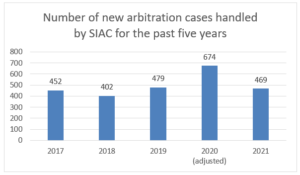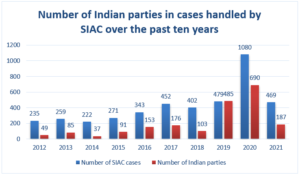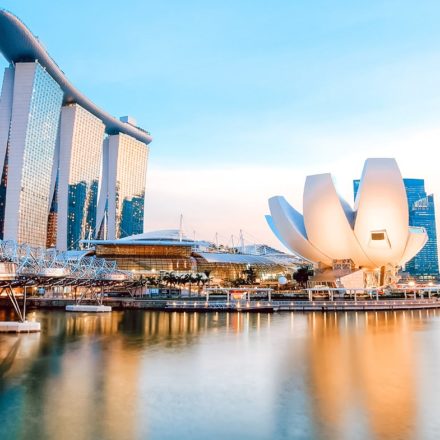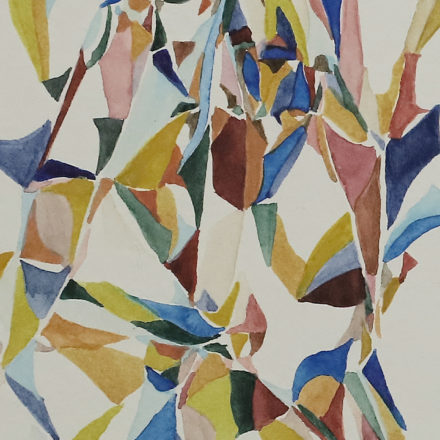2021 marked the 30th anniversary of the Singapore International Arbitration Centre (“SIAC”), a year with its third-highest caseload with 469 new case filings, and a year in which it changed its Board of Directors, Court of Arbitration and management.
SIAC’s 2021 statistics, which can be seen here, see a reversion to its pre-pandemic levels in 2019 in both caseload and value in dispute. The dramatic rise in new SIAC cases in 2020 seems to have been caused by the immediate rise in smaller-value trade cases caused by the pandemic.
Some of the highlights include:
New arbitration cases
- In 2021, the number of new arbitration cases filed at SIAC was its third highest historically, at 469, although the figure plummeted by over 50% from 2020’s extraordinary figure of 1,080 (although the caseload of 1,080, as we discussed here, was increased by two sub-sets of related cases, 261 and 145 cases respectively, which were consolidated. After adjustment, the caseload in 2020 was 674). The caseload in 2021 aligns more closely with SIAC’s pre-pandemic trend of between 400 to 500 new cases annually since 2017.

- Apart from SIAC, the other major arbitration institutions are also showing a drop of cases in 2021 from 2020. The caseload of the International Chamber of Commerce (“ICC”) dropped from 946 to 853, that of the London Court of International Arbitration (“LCIA”) dropped from 440 to 377, and that of the Hong Kong International Arbitration Centre (“HKIAC”) dropped from 318 to 277.
- In 2020, around 70% of the contracts for the cases filed at SIAC were entered into during the period from 2019 to 2020. When looking at this year’s statistics and back at previous statistics, this is atypical. In 2021, the comparable figure for 2020 to 2021 was 40.4%; in 2019, contracts entered into from 2018 to 2019 generated 35.5% of the cases; and in 2018, contracts entered into from 2017 to 2018 generated 35.5% of the cases as well. This seems to show that the disruption of the pandemic generated many immediate disputes in 2020 in comparison to other years and SIAC is now seeing a more typical caseload.
Value in dispute
- The decline in SIAC’s caseload was matched by a decrease in the total value in dispute for its new cases by approximately 22% from USD8.49 billion in 2020 to USD6.54 billion in 2021. Nevertheless, the average value in dispute of SIAC increased from USD19.26 million in 2020 to USD21.81 million in 2021. However, this is still far short of the average value in dispute in 2019 (USD30.99 million).
- Comparatively, although SIAC received almost 200 more new cases than the HKIAC, the HKIAC had a higher total amount in dispute of USD7 billion and a higher average value in dispute of USD24.8 million. From the preliminary 2021 statistics released by the ICC, the ICC continued to receive higher-value, more complex disputes.
Geographical spread of parties
- 86% of the new cases filed with SIAC in 2021 were international in nature, reduced from 94% in 2020 (although similar to 87% in 2019).
- The number of Singaporean parties for new cases handled by SIAC decreased from 972 in 2020 to 467 in 2021 (again, similar to 416 in 2019), but still exceeding the largest foreign user.
- SIAC’s top 10 foreign users in 2021 shuffled compared to 2020. Whilst India continued to lead the chart with 187 cases filed, the United States of America dropped from second place to fourth place with only 74 cases filed, trailing China (94 cases) and Hong Kong (80 cases), both of which jumped up to second and third from their respective positions at third and seventh place in 2020. Switzerland, Thailand, Japan and Cayman Islands were no longer ranked in SIAC’s top 10 foreign users, whereas Malaysia, South Korea, and the United Arab Emirates re-entered the top 10. Further, SIAC also saw an increase in the number of parties from Ukraine (39 cases).
- In line with the findings of the Queen Mary arbitration survey released in 2021 which ranked SIAC as the most preferred arbitral institution in the Asia-Pacific, most of SIAC’s top foreign users are in Asia.
- In general, the number of foreign parties reverted to their 2019 levels, with the exception of India. As shown in the graph below, the number of Indian parties increased overall throughout the past ten years, with particularly huge jumps in 2019 and 2020. However, in 2021, the number of Indian parties dropped to less than half of the level in 2019. India has been the top-ranking foreign user for seven years out of the last ten years. The graph seems to demonstrate that the increase in SIAC cases has been driven by the increase in India-related disputes being heard at SIAC.

Arbitrator appointments
- Interestingly, the dive in the number of new cases was not accompanied by a drop in arbitrator appointments but an increase on 2020 and 2019. In 2019, 297 arbitrators were appointed or confirmed by SIAC; in 2020, 288 arbitrators were appointed or confirmed; in 2021, this figure jumped to 371. Some of these appointments are likely to have been for cases commenced in 2020 as there is typically a time lag from the filing of a Notice of Arbitration to the appointment of the tribunal.
- The number of arbitrators from India, China and Hong Kong all increased, showing increasingly geographical diversity.
Types of disputes
- The new cases filed at SIAC in 2021 were more varied than those from 2020.
- Commercial cases saw a marked threefold percentage increase from 8% in 2020 to 24% in 2021. In absolute numbers, there continued to be a decrease of construction cases and corporate cases from 2019 (76 construction cases, 140 corporate cases) and 2020 (49 construction cases, 80 corporate cases) to 41 construction cases and 66 corporate cases in 2021. Both corporate and construction cases tend to be higher-value, multi-party claims and the decrease in these cases may explain the drop in SIAC’s average claim value in 2021 compared to 2019.
- Trade-related disputes dropped from 64% in 2020 to 30% in 2021 – with the percentage more aligned with 2019 (21%). Consistent with our other observations, the immediate effects of the pandemic were seen in smaller-value trade disputes in 2020.
Renewal at SIAC
In 2021, SIAC appointed new SIAC Court President, Court Vice President, Deputy Chairman, SIAC Board Members, and SIAC Court Members. Some of these new appointments are listed below.
SIAC Court of Arbitration
- Ms Lucy Reed, a Vice President of the SIAC Court of Arbitration since 2018, was promoted to President.
- Mr Toby Landau QC was appointed as Vice President.
- Nine new members were appointed to the SIAC Court of Arbitration.
SIAC’s Board of Directors
- Mr Chong Yee Leong was appointed as Deputy Chairman of SIAC.
- Five new directors, Ms Lucy Reed, Mr Siraj Omar SC, Mr Gerald Singham, Mr Luke Sobota and Ms Ariel Ye, were appointed to SIAC’s Board. Ariel is a partner in our firm’s Beijing and Shenzhen offices.
SIAC CEO, Registrar and COO
- Ms Gloria Lim was appointed as the Chief Executive Officer.
- Mr Kevin Nash was appointed as the Registrar having previously been Deputy Registrar.
- Ms Lee Yoke Peng was appointed as the Chief Operating Officer.









